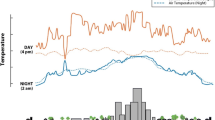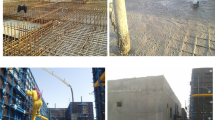Abstract
Foam concrete is widely used in wall construction due to its high thermal and acoustic insulation, hence reducing energy consumption and CO2 emission. Meanwhile, the palm oil industry results in an enormous number of by-products in forms of fibre, shell, ash and clinker. About 12 million tonnes of palm oil fuel ash (POFA) are produced annually and regularly disposed in landfills causing several environmental, economic and health adverse consequences. The purpose of this research is to investigate the performance of different types of lightweight load-bearing panels under axial loading and the effect of using POFA as a sand replacement on the behaviour of the panels. A total of 16 panels were tested and compared in terms of bearing capacity and cost efficiency using four-panel types, namely normal, reinforced, fibreglass confined and infilled steel sheet panels. Two mixtures were used in panels casting: 0% and 40% POFA. The results showed that using POFA increased the capacity and slightly increased the ductility of the panels. Among the different panel types, the use of fibreglass mesh resulted in the highest axial capacity and ductility. However, reinforced and filled steel panels showed better brittleness and established a slight increase in the capacity compared to the normal panels. In addition, fibreglass confined panels are more cost-efficient compared with the reinforced and infilled panels. In conclusion, fibreglass confined panels demonstrated the best performance, and the use of POFA as a sand replacement significantly improves foam concrete strength.













Similar content being viewed by others
References
Aiello MA, Micelli F, Valente L (2009) FRP confinement of square masonry columns. J Compos Constr 13:148–158
Alnahhal AM, Alengaram UJ, Yusoff S, Singh R, Radwan MK, Deboucha W (2021) Synthesis of sustainable lightweight foamed concrete using palm oil fuel ash as a cement replacement material. J Build Eng 35:102047
Al-Shwaiter A, Awang H (2020) The influence of superplasticisers on the fresh and mechanical behaviour of foam concrete utilizing pofa as sand replacement. J Teknol 83:57–65
Al-Shwaiter A, Awang H, Khalaf MA (2021) The Influence of superplasticiser on mechanical, transport and microstructure properties of foam concrete. J King Saud Univ Eng Sci. https://doi.org/10.1016/j.jksues.2021.02.010
Alwaeli M, Gołaszewski J, Niesler M, Pizoń J, Gołaszewska M (2020) Recycle option for metallurgical sludge waste as a partial replacement for natural sand in mortars containing CSA cement to save the environment and natural resources. J Hazard Mater 398:123101. https://doi.org/10.1016/j.jhazmat.2020.123101
Amran YM, Farzadnia N, Ali AA (2015) Properties and applications of foamed concrete; a review. Constr Build Mater 101:990–1005
Amran YM, Rashid RS, Hejazi F, Safiee NA, Ali AA (2016) Response of precast foamed concrete sandwich panels to flexural loading. J Build Eng 7:143–158
Astm C1116 (2002) Standard specification for fiber-reinforced concrete and shotcrete
Awang H, Arminda W (2019) Effect of POFA foamed concrete block on indoor air temperatures. In: IOP Conference Series: Materials Science and Engineering, 603:052022
Ayyam V, Palanivel S, Chandrakasan S (2019) Sand mining and strategies for its management. Coastal ecosystems of the tropics-adaptive management. Springer, New York
Baki VA, Nayır S, Erdoğdu Ş, Ustabaş İ (2020) Determination of the pozzolanic activities of trachyte and rhyolite and comparison of the test methods implemented. Int J Civ Eng 18:1053–1066
Bs-En-12390–3 (2009) Testing concrete -Part 116: method for determination of compressive strength of concrete cubes
Cengiz O, Turanli L (2004) Comparative evaluation of steel mesh, steel fibre and high-performance polypropylene fibre reinforced shotcrete in panel test. Cem Concr Res 34:1357–1364
Cong M, Bing C (2015) Properties of a foamed concrete with soil as filler. Constr Build Mater 76:61–69. https://doi.org/10.1016/j.conbuildmat.2014.11.066
Dunn TP, Van Zijl GP, Van Rooyen AS (2018) Investigating a reinforced lightweight foamed concrete walling system for low-rise residential buildings in moderate seismic regions. J Build Eng 20:663–670
Eltayeb E, Ma X, Zhuge Y, Youssf O, Mills JE, Xiao J (2020a) Structural behaviour of composite panels made of profiled steel sheets and foam rubberised concrete under monotonic and cyclic shearing loads. Thin-Walled Struct 151:106726
Eltayeb E, Ma X, Zhuge Y, Youssf O, Mills JE, Xiao J, Singh A (2020b) Structural performance of composite panels made of profiled steel skins and foam rubberised concrete under axial compressive loads. Eng Struct 211:110448
Ms En 197–1 (2014) Cement- part 1: copmposition, specifications, and comformity criteria for common cement
En771–4 (2011) Specification for masonry units– Part 4: autoclaved aerated concrete masonry units
En-Bs1008 (2002) Mixing water for concrete-specification for sampling, testing, and assessing the suitability of water, including water recovered from processes in the concrete industry, as mixing water for concrete. British Stan-dards Institution, London
Fernando P, Jayasinghe M, Jayasinghe C (2017) Structural feasibility of expanded polystyrene (EPS) based lightweight concrete sandwich wall panels. Constr Build Mater 139:45–51
Fu Y, Wang X, Wang L, Li Y (2020) Foam concrete: a state-of-the-art and state-of-the-practice review. Adv Mater Sci Eng 2020:6153602. https://doi.org/10.1155/2020/6153602
Gencel O, Oguz M, Gholampour A, Ozbakkaloglu T (2021) Recycling waste concretes as fine aggregate and fly ash as binder in production of thermal insulating foam concretes. J Build Eng 38:102232
Hamada HM, Jokhio GA, Yahaya FM, Humada AM, Gul Y (2018) The present state of the use of palm oil fuel ash (POFA) in concrete. Constr Build Mater 175:26–40
Hamada HM, Thomas BS, Yahaya FM, Muthusamy K, Yang J, Abdalla JA, Hawileh RA (2021) Sustainable use of palm oil fuel ash as a supplementary cementitious material: a comprehensive review. J Build Eng 40:102286. https://doi.org/10.1016/j.jobe.2021.102286
Hussin MW, Abdullah K (2009) Properties of palm oil fuel ash cement based aerated concrete panel subjected to different curing regimes. Malays J Civ Eng 21:17–31
Johnson E, Li Q (2012) Structural behaviour of composite sandwich panels with plain and fibre-reinforced foamed concrete cores and corrugated steel faces. Compos Struct 94:1555–1563
Jones MR, Mccarthy A (2005) Preliminary views on the potential of foamed concrete as a structural material. Mag Concr Res 57:21–31
Kumar VN, Arunkumar C, Srinivasa Senthil S (2018) Experimental study on mechanical and thermal behavior of foamed concrete. Mater Today Proc 5:8753–8760. https://doi.org/10.1016/j.matpr.2017.12.302
Lim SK, Tan CS, Lim OY, Lee YL (2013) Fresh and hardened properties of lightweight foamed concrete with palm oil fuel ash as filler. Constr Build Mater 46:39–47
Ma C, Chen B (2017) Experimental study on the preparation and properties of a novel foamed concrete based on magnesium phosphate cement. Constr Build Mater 137:160–168
Mehta PK (2002) Greening of the concrete industry for sustainable development. Concr Int 24:23–28
Mohamad N, Omar W, Abdullah R (2012) Structural behaviour of precast lightweight foamed concrete sandwich panel as a load bearing wall. OIDA Int J Sustain Dev 5:49–58
Moon FL, Yi T, Leon RT, Kahn LF (2007) Testing of a full-scale unreinforced masonry building following seismic strengthening. J Struct Eng 133:1215–1226
Mugahed Amran YH, Alyousef R, Alabduljabbar H, Alrshoudi F, Rashid RSM (2019) Influence of slenderness ratio on the structural performance of lightweight foam concrete composite panel. Case Stud Constr Mater 10:e00226. https://doi.org/10.1016/j.cscm.2019.e00226
Muthusamy K, Mirza J, Zamri NA, Hussin MW, Majeed APA, Kusbiantoro A, Budiea AMA (2019) Properties of high strength palm oil clinker lightweight concrete containing palm oil fuel ash in tropical climate. Constr Build Mater 199:163–177
Mydin MO, Wang Y (2011) Structural performance of lightweight steel-foamed concrete–steel composite walling system under compression. Thin-Walled Struct 49:66–76
Nambiar EK, Ramamurthy K (2008) Fresh state characteristics of foam concrete. J Mater Civ Eng 20:111–117
Narayanan JS, Ramamurthy K (2012) Identification of set-accelerator for enhancing the productivity of foam concrete block manufacture. Constr Build Mater 37:144–152
Ni FM-W, Oyeyi AG, Tighe S (2020) The potential use of lightweight cellular concrete in pavement application: a review. Int J Pavement Res Technol 13:686–696
Papanicolaou C, Triantafillou T, Lekka M (2011) Externally bonded grids as strengthening and seismic retrofitting materials of masonry panels. Constr Build Mater 25:504–514
Prabha P, Marimuthu V, Saravanan M, Palani G, Lakshmanan N, Senthil R (2013) Effect of confinement on steel-concrete composite light-weight load-bearing wall panels under compression. J Constr Steel Res 81:11–19
Primmer P (2018) The use of EN771-4 the European harmonized AAC masonry unit product standard in the UK. Ce/papers 2:565–570
Prota A, Marcari G, Fabbrocino G, Manfredi G, Aldea C (2006) Experimental in-plane behavior of tuff masonry strengthened with cementitious matrix–grid composites. J Compos Constr 10:223–233
Raj A, Sathyan D, Mini KM (2019) Physical and functional characteristics of foam concrete: a review. Constr Build Mater 221:787–799. https://doi.org/10.1016/j.conbuildmat.2019.06.052
Sahu SS (2021) Studies on influence of characteristics of surfactant and foam on foam concrete behaviour. J Build Eng 40:102333. https://doi.org/10.1016/j.jobe.2021.102333
Sathiparan N, Nissanka N, Priyankara R (2016) A comparative study of meshtype retrofitting for unreinforced masonry under in-plane loading. Arab J Sci Eng 41:1391–1401
Song Y, Lange D (2019) Crushing performance of ultra-lightweight foam concrete with fine particle inclusions. Appl Sci 9:876
Song H, Tang M, Lei X, Feng Z, Cheng F (2020) Preparation of ultrafine fly ash-based superhydrophobic composite coating and its application to foam concrete. Polymers 12:2187
Tai ZS, Hubadillah SK, Othman MHD, Dzahir MIHM, Koo KN, Tendot NISTI, Ismail AF, Rahman MA, Jaafar J, Abd Aziz MH (2019) Influence of pre-treatment temperature of palm oil fuel ash on the properties and performance of green ceramic hollow fiber membranes towards oil/water separation application. Sep Purif Technol 222:264–277
Thomas BS, Kumar S, Arel HS (2017) Sustainable concrete containing palm oil fuel ash as a supplementary cementitious material–a review. Renew Sustain Energy Rev 80:550–561
Villiers D, Van Zijl GP, Van Rooyen AS (2017) Bond of deformed steel reinforcement in lightweight foamed concrete. Struct Concr 18:496–506
Xu Z, Chen Z, Yang S (2018) Seismic behavior of cold-formed steel high-strength foamed concrete shear walls with straw boards. Thin-Walled Struct 124:350–365
Yahaya FM, Muthusamy K, Hussin MW (2015) Long term investigation on sulphate resistance of aerated concrete containing palm oil fuel ash. ARPN J Eng Appl Sci 11:2406–2411
Zhai W, Ding J, An X, Wang Z (2020) An optimization model of sand and gravel mining quantity considering healthy ecosystem in Yangtze River China. J Clean Prod 242:118385
Acknowledgements
The authors gratefully acknowledge the Universiti Sains Malaysia for providing financial support to this research through the USM RUI Grant Ref. No. 1001/PPBGN/8014015.
Author information
Authors and Affiliations
Corresponding author
Rights and permissions
About this article
Cite this article
Al-Shwaiter, A., Awang, H. The Behaviour of the Different Types of Foam Concrete Load-Bearing Panels Utilising Palm Oil Fuel Ash as a Sand Replacement. Iran J Sci Technol Trans Civ Eng 46, 2873–2883 (2022). https://doi.org/10.1007/s40996-021-00782-w
Received:
Accepted:
Published:
Issue Date:
DOI: https://doi.org/10.1007/s40996-021-00782-w




